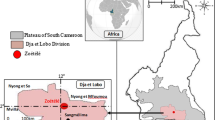Abstract
Compressed cement-soil block is known as low cost building materials. This paper studies the effects of soil grading and the characteristics of soil on the properties of compressed cement-soil such as compressive strength, dry density and water absorption. Compacting pressure of 10 MPa and 30% binder with respect to cement content of 10% were used. The results obtained from crushed soil particles were better than those from natural soil. Mixture of 35% soil and 65% sand produced the optimum of strength, dry density and water absorption. Strength and dry density increased with the fineness of soil particles. Moreover, soil properties also affect the strength properties of cement-soil. Its strength is significantly reduced with increasing plasticity index or liquid limit.
Similar content being viewed by others
References
Ahnberg, H. and Holm, G. (1999). “Stablisation of some Swedish organic soils with different types of binder.” Proceeding of the International Conference on Dry Mix Method for Deep Soil Stabilisation, Stockholm, pp. 101–108.
Ahnberg, H., Johansson, S.-E., Pihl, H., and Carlsson, T. (2003). “Stabilizing effects of different binders in some Swedish soils.” Ground Improvement, Vol. 7, No. 1, pp. 9–23.
Anthony, G. K. (2001). Durability of compressed and cement-stabilised building blocks, PhD Thesis, University of Warwick, Coventry, England.
ASTM C136 (2006). Standard test method for sieve analysis of fine and coarse aggregates, USA.
ASTM D422 (1963). Standard test method for particle-size analysis of soils, USA.
Carter, M. and Bentley, S. P. (1991). Correlations of soil properties, Pentech Press, London, England.
Das, B. M. (1983). Fundamentals of soil dynamics, Elsevier Science Publishing Co., New York, USA.
Enteiche, A. (1964). Soil cement; Its use in Building, United Nations Publications, New York, USA
Fitzmaurice, R. (1958). Manual on stabilized soil construction for housing, Technical Assistance Program, United Nations, New York.
Hebib, S. and Farrell, E. (1999). “Some experience of stabilizing Irish organic soils.” Proceeding of the International Conference on Dry Mix Method for Deep Soil Stabilization, Stockholm, pp. 81–84.
Houben, H. and Guillaud, H. (1994). Earth construction: A comprehensive guide, IT Publication, London.
Jimenez Delgado, M. C. and Guerrero, I. C. (2007). “The selection of soil for unstabilised earth building: A normal review.” Construction and Building Materials, Vol. 21, No. 2, pp. 237–251.
Mohamed, A. M. O. (2000). “The role of clay minerals in marly soil on its stability.” Engineering Geology, Vol. 57, Issues 3–4, pp. 193–203.
Morel, J. C., Abalo Pkla, and Walker, P. (2007). “Compressive strength testing of compressed earth blocks.” Construction and Building Materials, Vol. 21, No. 2, pp. 303–309.
Walker, P. (1995). “Strength, durability and shrinkage characteristics of cement stabilized soil blocks.” Cement and Concrete Composites, Vol. 17, No. 4, pp. 301–310.
Walker, P. and Stace, T. (1997). “Properties of some cement stabilized compressed earth blocks and mortars.” Materials and Structures, Vol. 30, November, pp. 545–551.
Walker, P. J. (2004). “Strength and erosion characteristics of earth blocks and earth block masonry.” Journal of Materials in Civil Engineering, ASCE, Vol. 16, No. 5, pp. 497–506.
Venkatarama Reddy, B. V. and Gupta, A. (2005). “Characteristics of soil-cement blocks using highly sandy soils.” Materials and Structures, Vol. 38, No. 6, pp. 651–658.
Venkatarama Reddy, B. V. and Walker, P. (2005). “Stabilised mud blocks: Problems, prospects.” Proc., Int. Earth Building Conf. Earth-Build 2005, Sydney, Australia, pp. 63–75.
Venkatarama Reddy, B. V., Richardson, L., and Nanjunda Rao, K. S. (2007). “Optimum grading for the soil-cement blocks.” Journal of Materials in Civil Engineering, ASCE, Vol. 19, No. 2, pp. 139–148.
Veith, G. (2000). “Green, ground and great: Soil stabilization with slag.” Building Research & Information, Vol. 28, No. 1, pp. 70–72.
Author information
Authors and Affiliations
Corresponding author
Rights and permissions
About this article
Cite this article
Kwon, HM., Le, A.T. & Nguyen, N.T. Influence of soil grading on properties of compressed cement-soil. KSCE J Civ Eng 14, 845–853 (2010). https://doi.org/10.1007/s12205-010-0648-9
Received:
Revised:
Accepted:
Published:
Issue Date:
DOI: https://doi.org/10.1007/s12205-010-0648-9




